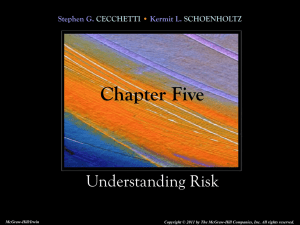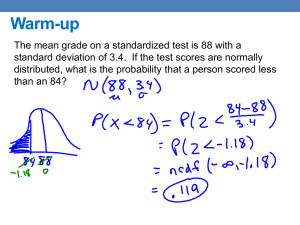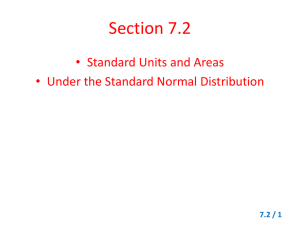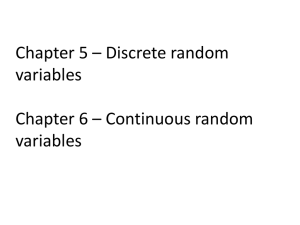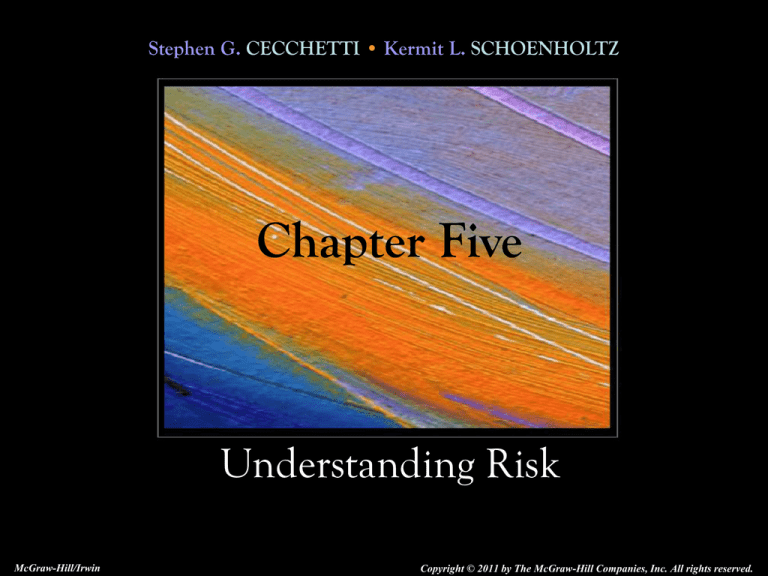
Stephen G. CECCHETTI • Kermit L. SCHOENHOLTZ
Chapter Five
Understanding Risk
McGraw-Hill/Irwin
Copyright © 2011 by The McGraw-Hill Companies, Inc. All rights reserved.
Introduction
• Risk cannot be avoided.
• Everyday decisions involve financial and
economic risk.
• How much car insurance should I buy?
• Should I refinance my mortgage now or later?
• We must have the capacity to measure risk to
calculate a fair price for transferring risk.
5-2
Outline
In this chapter we will:
1. Learn to measure risk and assess whether it
will increase or decrease.
2. Understand why changes in risk lead to
changes in the demand for a particular
financial instrument.
3. Understand why change in risk lead to
corresponding changes in the price of those
instruments.
5-3
Defining Risk
• According to the dictionary, risk is “the
possibility of loss or injury.”
• For outcomes of financial and economic
decisions, we need a different definition.
Risk is a measure of uncertainty about the future
payoff to an investment, measured over some
time horizon and relative to a benchmark.
5-4
Defining Risk
1. Risk is a measure that can be quantified.
• The riskier the investment, the less
desirable and the lower the price.
2. Risk arises from uncertainty about the future.
• We do not know which of many possible
outcomes will follow in the future.
3. Risk has to do with the future payoff of an
investment.
• We must imagine all the possible payoffs
and the likelihood of each.
5-5
Defining Risk
4. Definition of risk refers to an investment or
group of investments.
•
Investment described very broadly.
5. Risk must be measured over some time
horizon.
•
In general, risk over shorter periods is lower.
6. Risk must be measured relative to some
benchmark - not in isolation.
•
A good benchmark is the performance of a group
of experienced investment advisors or money
managers.
5-6
Measuring Risk
• We must become familiar with the
mathematical concepts useful in thinking about
random events.
• In determining expected inflation or expected
return, we need to understand expected value.
• The investments return out of all possible values.
5-7
Possibilities, Probabilities, and
Expected Value
• Probability theory states that considering
uncertainty requires:
• Listing all the possible outcomes.
• Figuring out the chance of each one occurring.
• Probability is a measure of the likelihood that
an event will occur.
• It is always between zero and one.
• Can also be stated as frequencies.
5-8
Possibilities, Probabilities, and
Expected Value
• We can construct a table of all outcomes and
probabilities for an event, like tossing a fair
coin.
5-9
Possibilities, Probabilities, and
Expected Value
• If constructed correctly, the values in the
probabilities column will sum to one.
• Assume instead we have an investment that can
rise or fall in value.
• $1000 stock which can rise to $1400 or fall to $700.
• The amount you could get back is the investment’s
payoff.
• We can construct a similar table and determine the
investment’s expected value - the average or most
likely outcome.
5-10
Possibilities, Probabilities, and
Expected Value
• Expected value is the mean - the sum of their
probabilities multiplied by their payoffs.
Expected Value = 1/2($700) + 1/2($1400) = $1050
5-11
• Are you saving enough for retirement?
• You might be tempted to assume your
investments will grow at a certain rate, but
understand that is not the only possibility.
• You need to know what the possibilities are
and how likely each one is.
• Then you can assess whether your retirement
savings plan is risky or not.
5-12
Possibilities, Probabilities, and
Expected Value
What if $1000 Investment could
1. Rise in value to $2000, with probability of
0.1
2. Rise in value to $1400, with probability of
0.4
3. Fall in value to $700, with probability of 0.4
4. Fall in value to $100, with probability of 0.1
5-13
Possibilities, Probabilities, and
Expected Value
Expected Value =
0.1x($100) + 0.4x($700) + 0.4x($1400) +0.1x($2000) = $1050
5-14
Possibilities, Probabilities, and
Expected Value
• Using percentages allows comparison of
returns regardless of the size of initial
investment.
• The expected return in both cases is $50 on a $1000
investment, or 5 percent.
• Are the two investments the same?
• No - the second investment has a wider range of
payoffs.
• Variability equals risk.
5-15
Measures of Risk
• It seems intuitive that the wider the range of
outcomes, the greater the risk.
• A risk free asset is an investment whose future
value is knows with certainty and whose return
is the risk free rate of return.
• The payoff you receive is guaranteed and cannot
vary.
• Measuring the spread allows us to measure the
risk.
5-16
Variance and Standard Deviation
•
The variance is the average of the squared
deviations of the possible outcomes from their
expected value, weighted by their
probabilities.
1. Compute expected value.
2. Subtract expected value from each of the possible
payoffs and square the result.
3. Multiply each result times the probability.
4. Add up the results.
5-17
Variance and Standard Deviation
1. Compute the expected value:
($1400 x ½) + ($700 x ½) = $1050.
2. Subtract this from each of the possible payoffs and square the
results:
$1400 – $1050 = ($350)2 = 122,500(dollars)2 and
$700 – $1050 = (–$350)2 =122,500(dollars)2
3. Multiply each result times its probability and add up the results:
½ [122,500(dollars)2] + ½ [122,500(dollars)2] =122,500(dollars)2
The Standard deviation is the square root of the variance:
= Variance = 122,500 dollars 2 = $350
5-18
Variance and Standard Deviation
• The standard deviation is more useful because
it deals in normal units, not squared units (like
dollars-squared).
• We can calculate standard deviation into a
percentage of the initial investment, $1000, or
35 percent.
• We can compare other investments to this one.
• Given a choice between two investments with
equal expected payoffs, most will choose the
one with the lower standard deviation.
5-19
Measuring Risk: Case 2
5-20
Variance and Standard Deviation
• The greater the standard deviation, the higher
the risk.
• Case one has a standard deviation of $350
• Case two has a standard deviation of $528
• Case one has lower risk.
• We can also see this graphically:
5-21
Variance and Standard Deviation
• We can see Case 2 is more spread out - higher standard deviation.
5-22
Leverage raises the expected value and the standard deviation.
Calculation of the STD and Expected value is in the next slide
52
Leverage Ratio, Expected value and Standard
Deviation
Leverage raises the expected value and the standard deviation.
Example: Previous slide on the right
Leverage Ratio = Total Investment / Your Investment
With $1000 of your investment and $ 1000 borrowed fund, your total
possible payoffs are: 1400*2 or 700*2.
But you have to pay back the borrowed fund, so you end up with either
1400*2-1000=1800 or 700*2-1000=400, from your $1000 investment.
So the expected value is: 0.5*1800 + 0.5* 400=1100.
So since you either get 400 or 1800 from your $1000 investment, with an
expected value of 1100, your standard deviation is:
Sqrt(0.5*(400-1100)^2 + 0.5*(1800-1100)^2) = 700.
Conclusion: n times of leverage, then expected r increases by n times
and standard deviation increases by n times.
52
Risk Aversion, the Risk Premium, and
the Risk-Return Trade-off
• Most people do not like risk and will pay to
avoid it because most of us are risk averse.
• Insurance is a good example of this.
• A risk averse investor will always prefer an
investment with a certain return to one with the
same expected return but any amount of
uncertainty.
• Therefore, the riskier an investment, the higher
the risk premium.
• There is a tradeoff between risk and expected
return.
5-25
Sources of Risk: Idiosyncratic and
Systematic Risk
• All risks can be classified into two groups:
1. Those affecting a small number of people but
no one else:
idiosyncratic or unique risks
2. Those affecting everyone:
systematic or economy-wide risks
5-26
Sources of Risk: Idiosyncratic and
Systematic Risk
•
Idiosyncratic risks can be classified into two
types:
1. A risk is bad for one sector of the economy but
good for another.
• A rise in oil prices is bad for car industry but
good for the energy industry.
2. Unique risks specific to one person or company
and no one else.
5-27
Sources of Risk: Idiosyncratic and
Systematic Risk
5-28
Reducing Risk through Diversification
• Some people take on so much risk that a single
big loss can wipe them out.
• Traders call this “blowing up.”
• Risk can be reduced through diversification,
the principle of holding more than one risk at a
time.
• This reduces the idiosyncratic risk an investor
bears.
• One can hedge risks or spread them among
many investments.
5-29
Hedging Risk
• Hedging is the strategy of reducing
idiosyncratic risk by making two investments
with opposing risks.
• If one industry is volatile, the payoffs are stable.
• Let’s compare three strategies for investing
$100:
• Invest $100 in GE.
• Invest $100 in Texaco.
• Invest half in each company.
5-30
Hedging Risk
• Investing $50 in each stock to ensure your
payoff.
• Hedging has eliminated your risk entirely.
5-31
Spreading Risk
• You can’t always hedge as investments don’t
always move in a predictable fashion.
• The alternative is to spread risk around.
• Find investments whose payoffs are unrelated.
• We need to look at the possibilities,
probabilities and associated payoffs of different
investments.
5-32
Spreading Risk
• Let’s again compare three strategies for
investing $1000:
• Invest $1000 in GE.
• Invest $1000 in Microsoft.
• Invest half in each company.
5-33
Spreading Risk
• We can see the distribution of outcomes from
the possible investment strategies.
• This figure clearly shows spreading risk lowers
the spread of outcome and lowers the risk.
5-34
Spreading Risk
• The more independent sources of risk you hold
in your portfolio, the lower your overall risk.
• As we add more and more independent sources
of risk, the standard deviation becomes
negligible.
• Diversification through the spreading of risk is
the basis for the insurance business.
5-35
HW
• Page 118: 1, 4, 6, 7, 11, 13, 14
5-36

